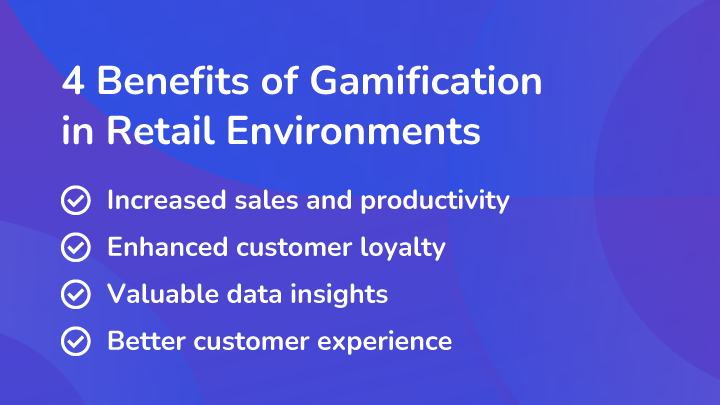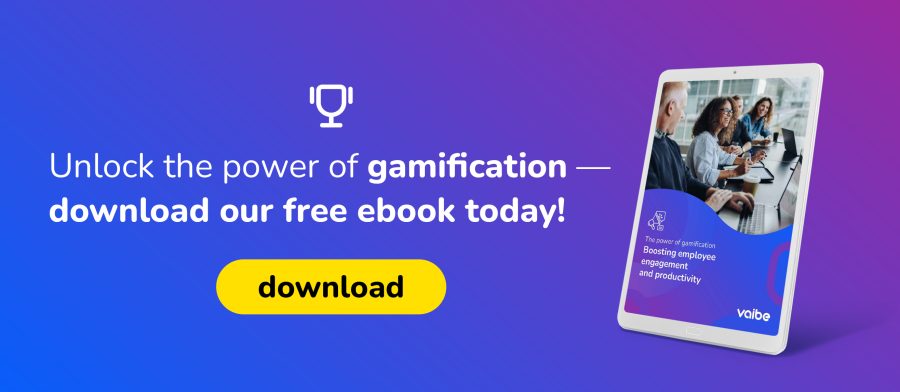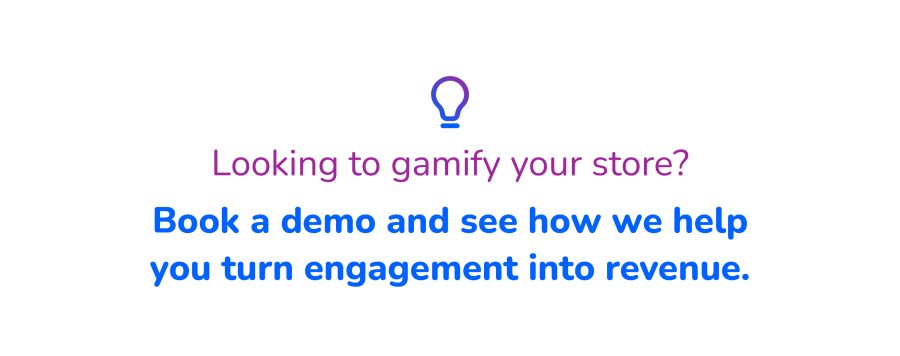Find actionable gamification strategies to enhance sales, reward retail teams, and build lasting customer loyalty.

Back to Blog
When it comes to hitting high targets in retail, increasing sales team performance has proved to be a significant challenge. Add enhancing customer satisfaction to the mix, and the struggle intensifies. According to a study by McKinsey, turnover rates are 70% higher in the retail industry compared to other sectors. This has a direct impact both on teams and sales results, also influencing customer satisfaction in the long run.
Sales teams thrive when they have clear goals and are motivated by tangible rewards. Gamification provides an engaging way to meet these needs by incorporating game-like challenges and recognition systems into daily routines. Discover how these techniques can be applied.
Gamification platforms allow retailers to set achievable, engaging targets for their sales teams, introducing a sense of accomplishment similar to leveling up in a game. For example, tracking key performance indicators (KPIs) like sales volume, upsell rates, and customer interactions can be gamified to provide real-time feedback, helping sales associates track their progress toward goals.
This approach has proven effective in motivating sales staff by adding clear milestones and reward-based incentives. In fact, sales teams with gamified tasks often show improved productivity and a greater willingness to engage with training materials, creating a higher-quality sales force that is better equipped to connect with customers.
Gamification also introduces intrinsic and extrinsic motivators that inspire peak performance. By rewarding specific actions, such as meeting sales quotas, providing excellent customer service, or demonstrating brand knowledge, retailers can foster a competitive but collaborative work environment. Points, badges, or leaderboards can reinforce these behaviors, creating an ongoing incentive for team members to reach their best performance.
Rewards could include cash bonuses, additional discounts, or experiences. In a gamified environment, associates are not only incentivized to perform well but are also more likely to feel valued and appreciated, further boosting morale and job satisfaction.

Gamified strategies don’t only benefit employees; they can transform the customer experience as well. Interactive loyalty programs and in-store challenges can be effective in increasing customer satisfaction and retention. But how can they be applied? Let’s discover.
One of the most effective ways gamification enhances customer satisfaction is through loyalty programs that offer points, badges, or milestones for making purchases, writing reviews, or interacting with brand content. Many customers enjoy the added excitement of working toward rewards like free products, exclusive discounts, or special access, making each shopping experience more engaging.
A gamified loyalty program can also create a sense of community, where customers compete or collaborate in earning rewards. This approach has been shown to increase retention, as customers are more likely to stay loyal to a brand that offers a unique, rewarding experience.

Retailers can elevate in-store experiences with interactive displays or mobile-based challenges that encourage customers to explore new products. For instance, scavenger hunts, where customers unlock rewards or discounts after discovering specific items, can add an exciting twist to the traditional shopping experience.
Interactive experiences also provide valuable data on customer preferences and behavior, allowing retailers to improve product offerings and tailor future promotions based on customer interests.
Gamification can make product education enjoyable for customers. By implementing gamified tutorials, quizzes, or interactive screens that guide customers on product use, retailers can increase confidence and reduce buyer hesitation. For example, beauty or tech retailers may provide a digital guide with a point system to educate customers on the benefits and features of various products, encouraging informed purchases and reducing return rates.

Some retailers use solutions like vaibe to transform the way they engage their teams, leveraging gamification to turn everyday tasks into motivating, interactive experiences. Here are several impactful use cases that illustrate how companies are moving beyond traditional rewards and engaging employees with interactive challenges, recognition, and rewards.
Retailers are implementing monthly or weekly customer service challenges, where employees earn points for actions like receiving positive feedback, quickly resolving issues, or going above and beyond for customers. Real-time leaderboards track achievements, and employees earn not only badges but also rewards redeemable for prizes. This approach fosters a consistently high standard of service, boosting customer satisfaction and, ultimately, customer loyalty.
Perfect attendance and punctuality are celebrated with points, badges, and streak-based rewards. Employees who maintain reliable attendance earn badges like “Perfect Month” and unlock bonuses for extended streaks. This gamified approach encourages a culture of accountability, reducing absenteeism and improving team reliability.
Sales challenges motivate employees to meet or exceed sales targets, with points awarded for achieving revenue goals or upselling products. Top performers are featured on leaderboards and can unlock tiered rewards like gift cards, cash bonuses, or extra time off. This fosters a healthy, competitive environment where employees are driven to exceed sales expectations.
To ensure employees stay informed about new products, retailers incorporate interactive quizzes and certification challenges. Points and “Product Pro” badges reward employees for completing quizzes with high scores, while extra incentives are given for perfect results. This boosts product knowledge, enabling employees to confidently guide customers and contribute to sales growth.
Routine tasks, such as inventory management or store maintenance, become more engaging with task-based rewards. Points recognition and rewards make these tasks feel rewarding. Regular completion of these essential duties improves store operations, enhancing the customer experience.
Team-based challenges encourage collaboration, with goals set for groups to work together toward shared outcomes, like hitting a sales target or reducing stock discrepancies. Points accumulate collectively, and team-wide rewards—like group outings or shared bonuses—celebrate these accomplishments, strengthening bonds and team spirit.
Peer-to-peer recognition allows employees to award each other “Kudos” points for supportive actions or exceptional performance. Recognition by peers is a powerful motivator, and top-recognized employees are celebrated with badges and rewards, cultivating a workplace culture of mutual appreciation and positivity.

vaibe’s platform stands out in gamification by providing a flexible, API-based solution tailored to the needs of retail businesses. With its Gamification-as-a-Service (GaaS) model, vaibe enables companies to seamlessly incorporate gamified experiences for both sales teams and customers.
Retailers can introduce competitive challenges, customizable loyalty programs, and interactive in-store experiences, all without the need for extensive development. By offering real-time tracking and analytics, vaibe helps retailers assess the effectiveness of gamification strategies, making it easy to refine approaches and ensure measurable improvements in engagement and satisfaction.
Try our gamification solution — no code, no big learning curves, just results.
Discover what Gamification-as-a-Service is and how API-based solutions can seamlessly integrate gamified elements into your existing software.
Learn how game mechanics, rewards and motivation strategies influence employee engagement.
Find out more about how vaibe gamification boosts operational efficiency in Supply Chain & Logistics with gamification.
Tiago Sottomayor, our CTO, named one of the ’10 Most Innovative Tech Leads’ by CIO Views Magazine 2024.